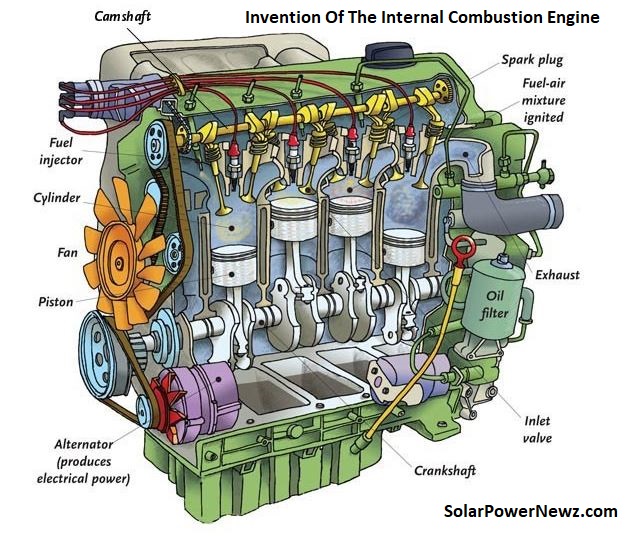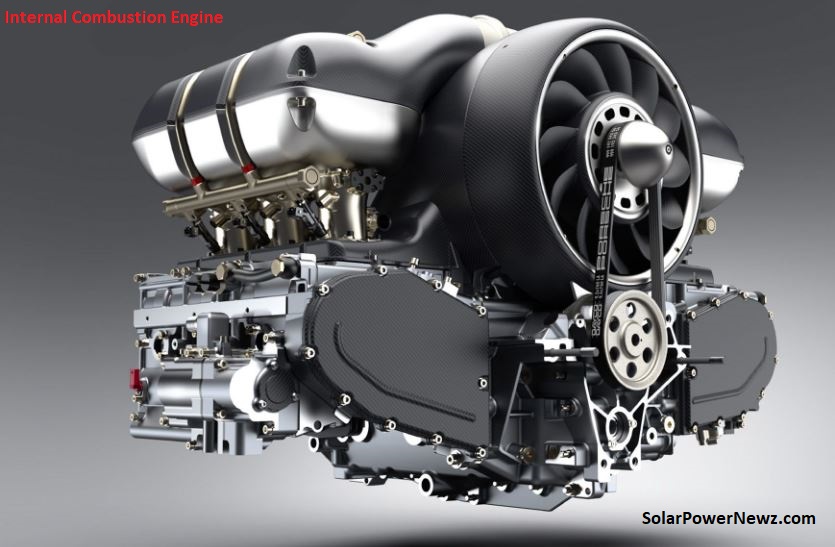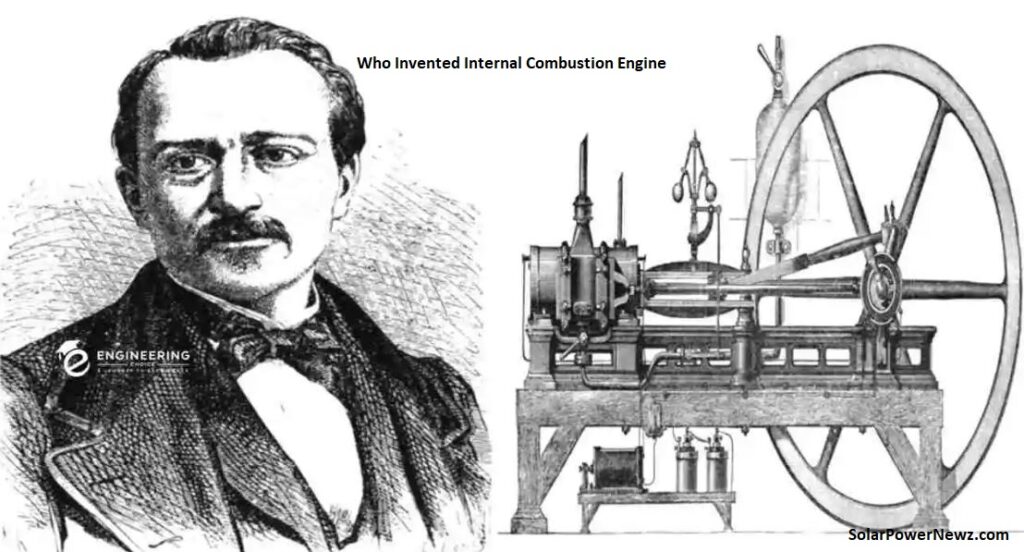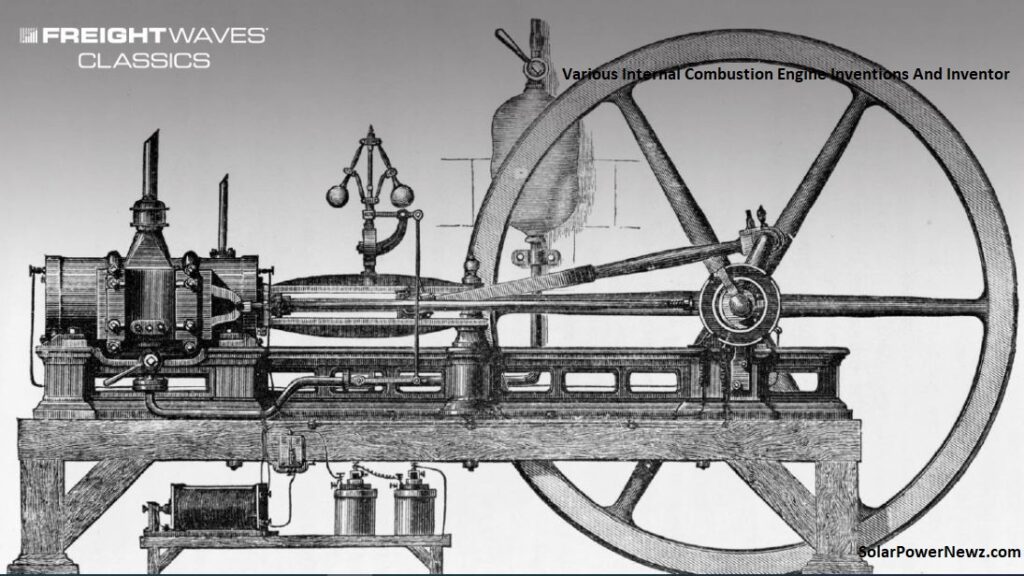Invention Of The Internal Combustion Engine, A Brief History

In this article we will discuss about Invention Of Internal Combustion Engine. An internal combustion engine burns fuel in the presence of oxygen and a spark plug. A piston is pushed into a cylinder by explosive combustion. The piston’s movement drives a crankshaft, which moves the wheels of a vehicle or the turbine blades. Cars, motorcycles, ships, aeroplanes, helicopters, and coal-fired trains are all commonly powered by internal combustion engines.

Consider a shotgun to be a form of internal combustion engine. In the presence of oxygen and a spark, gunpowder fuel explodes. This explosion produces a force in a cylinder, which produces work.
The work is accomplished by rapidly propelling an object ahead. In an internal combustion engine, the bullet is replaced with a piston that is shot forward forcibly. The linear motion of the piston is turned into the rotating motion of a wheel or turbine because it is coupled to a crankshaft.
Let’s take a look at the history of the internal combustion engine.
Table of Contents
Who Invented Internal Combustion Engine?

Samuel Brown developed the first internal combustion engine used industrially in the United States in 1823; one of his engines pumped water on the Croydon Canal from 1830 to 1836.
Étienne Lenoir invented the first commercially successful internal combustion engine circa 1860, while Nicolaus Otto invented the first modern internal combustion engine in 1876. George Brayton, an American, invented the first commercial liquid-fueled internal combustion engine in 1872.
Étienne Lenoir was born in 1822 in Mussy-la-Ville, which was then in Luxembourg but is now in Belgium. He moved to Paris, France, in the early 1850s, where he worked as an engineer and experimented with electricity.
In 1860, he patented a three-wheeled carriage with a gas-fired single-cylinder internal combustion engine. Although it operated relatively well, it was inefficient, noisy, and constantly overheated. If water was not supplied to cool the engine, it would shut down completely, and a tank was necessary to contain the gaseous fuel.
In 1863, he created a three-wheeled, gasoline-powered chariot. During a demonstration in Paris, the car covered 11 kilometres in almost three hours, corresponding to an average speed of three kilometres per hour.
Not at all quick! What was so amazing about a carriage going at such a sluggish pace? The fact that it was powered by a motor rather than a horse or mule was a significant advance. His engines were moderately successful, with roughly 500 engines made in all, but there was still plenty of potential for development.
Lenoir was granted French citizenship in 1870 for his assistance to the French during the Franco-Prussian War. For his contributions to telegraphy, he was awarded the Légion d’honneur in 1881. Despite effectively inventing the vehicle, Lenoir was impoverished in his final years. In 1900, he died in France.
Various Internal Combustion Engine Inventions And Inventor

While many scientists and engineers contributed to the development of the internal combustion engine. The original internal combustion engines lacked compression and instead functioned on an air-fuel mixture that could be inducted or injected during the first half of the intake stroke.
The use of compression, particularly in-cylinder compression, is the most fundamental distinction between current internal combustion engines and early versions.
History of the internal combustion engine:
- John Barber invented the gas turbine in 1791.
- Thomas Mead patented a gas engine in 1794. Robert Street also patented an internal combustion engine in 1794, which was also the first to use liquid fuel, and built an engine about the same time.
- John Stevens created the first American internal combustion engine in 1798.
- In 1807, Napoleon Bonaparte issued a patent to French engineers Nicéphore Niépce (who went on to discover photography) and Claude Niépce for the Pyréolophore, a prototype internal combustion engine that used controlled dust explosions. This engine propelled a boat along France’s Saône River. In the same year, Swiss engineer François Isaac de Rivaz developed a hydrogen-powered internal combustion engine with an electric spark.
- In 1808, De Rivaz fitted his innovation to a crude functional vehicle – “the world’s first internal combustion-powered the automobile”.
- Samuel Brown patented the first industrially applicable internal combustion engine in 1823.
- The Italian inventors Eugenio Barsanti and Felice Matteucci got the certification “Obtaining Motive Power by the Explosion of Gases” in the United Kingdom in 1854.
- The Great Seal Patent Office granted them patent No.1655 for a “Improved Apparatus for Obtaining Motive Power from Gases” in 1857. Between 1857 and 1859, Barsanti and Matteucci received patents for the same technology in France, Belgium, and Piedmont.
- Jean Joseph Etienne Lenoir, a Belgian, invented a gas-fired internal combustion engine in 1860.
- Nicolaus Otto patented the first atmospheric gas engine in 1864.
- In 1872, an American named George Brayton invented the first commercial liquid-fueled internal combustion engine.
- Nicolaus Otto, Gottlieb Daimler, and Wilhelm Maybach patented the compressed charge, four-cycle engine in 1876.
- In 1879, Karl Benz patented a durable two-stroke gasoline engine.
- Later, in 1886, Benz produced the first commercial production of internal combustion engine-powered motor vehicles, with a three-wheeled, four-cycled engine and chassis integrated into a single unit.
- In 1892, Rudolf Diesel developed the first compressed charge, compression ignition engine.
- Robert Goddard fired the first liquid-fueled rocket in 1926.
- The Heinkel He 178 became the world’s first jet aircraft in 1939.
- 15 May 1941: The Gloster E.28/39, powered by a Power Jets W.1 turbojet created by Frank Whittle and others, becomes the first British jet-engined aircraft to fly.
- 1942: Max Bentele discovers in Germany that turbine blades might break if vibrations are in their resonance region, a condition known from steam-turbine experience in the United States.
- The Messerschmitt Me 262 makes its first jet-engine flight on July 18, 1942.
- The Baylin Engine, a three-cycle internal combustion engine with rotary pistons, is invented by Samuel Baylin in 1946. A simple but complicated representation of the future Wankel engine.
- Engineers for The Texas Company—now Chevron—create a four-stroke engine with a fuel injector that uses the Texaco Combustion Process in 1951. Unlike traditional four-stroke gasoline engines, which use a separate valve for the intake of the air-gasoline mixture, the T.C.P. engine uses an intake valve with a built-in special shroud that delivers the air to the cylinder in a tornado-like fashion, followed by fuel injection and ignition by a spark plug. The inventors claimed that their engine could burn practically any petroleum-based fuel of any octane, as well as some alcohol-based fuels, such as kerosene, benzine, motor oil, tractor oil, and so on, without causing pre-combustion knock and complete combustion of the fuel injected into the cylinder.
- The Free-piston engine concept – a crankless internal-combustion engine – is developed by US businesses in the 1950s.
- Felix Wankel’s first functional prototype of the Wankel engine (DKM 54) was completed in 1954.
- 1986: Benz Gmbh files for patent protection on a Scotch yoke engine and begins development. Following that, development was halted.
- Ford Motor Company files a patent for a tiny turbine engine in 1996.
- 2004: Hyper-X becomes the first scramjet to retain altitude.
- Toyota Motor Corporation seeks for patent protection for a new type of Scotch yoke engine in 2004.
- 2021: At the United Nations Climate Change Conference in 2021, 30 countries signed a ban on internal combustion engines. Germany and numerous other conference attendees disagreed. In 2021, Deutz AG unveiled a revolutionary zero-emission hydrogen combustion engine.
- 2030: The United Kingdom will be the first to prohibit the sale of all new internal combustion engine automobiles.